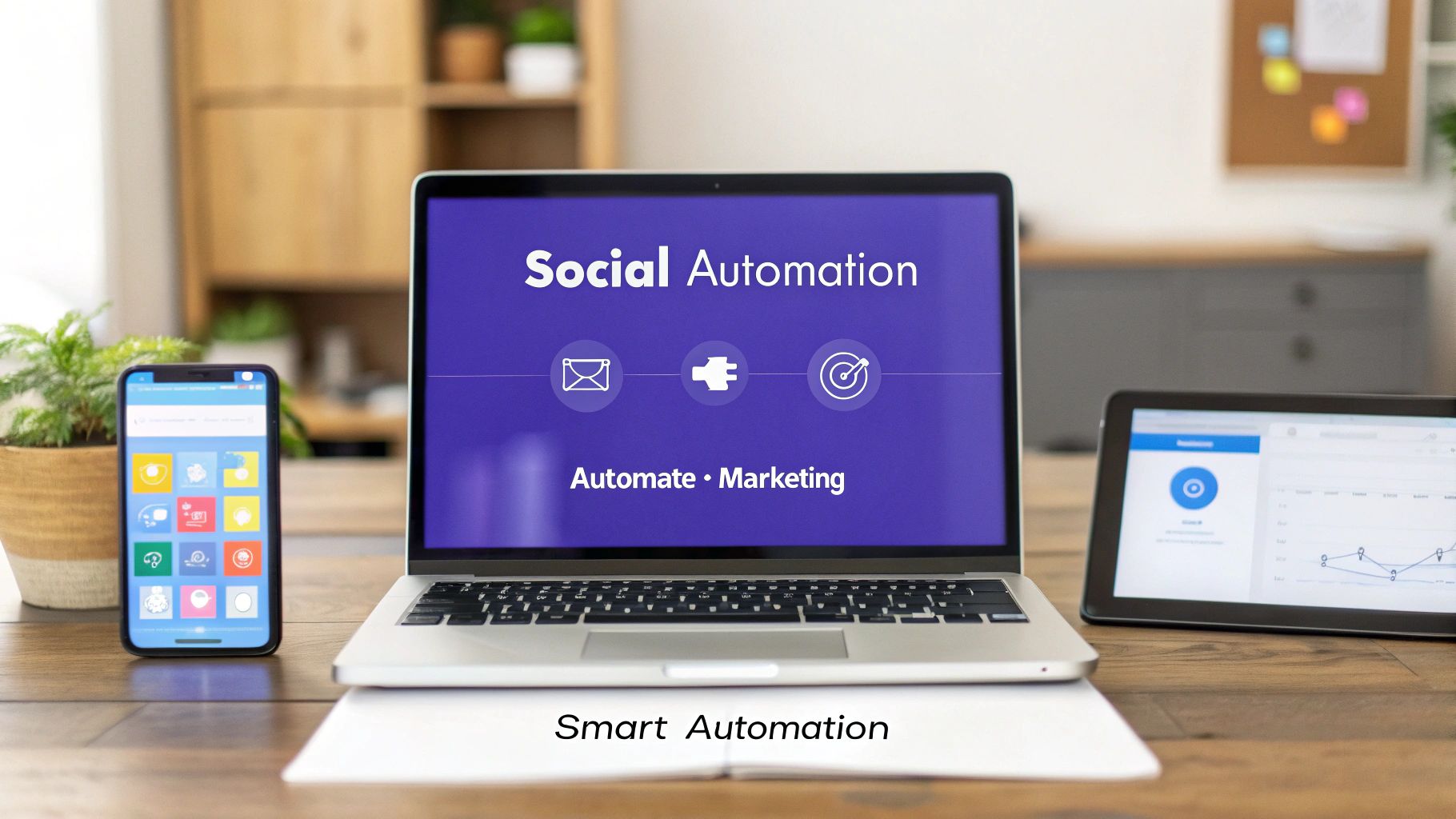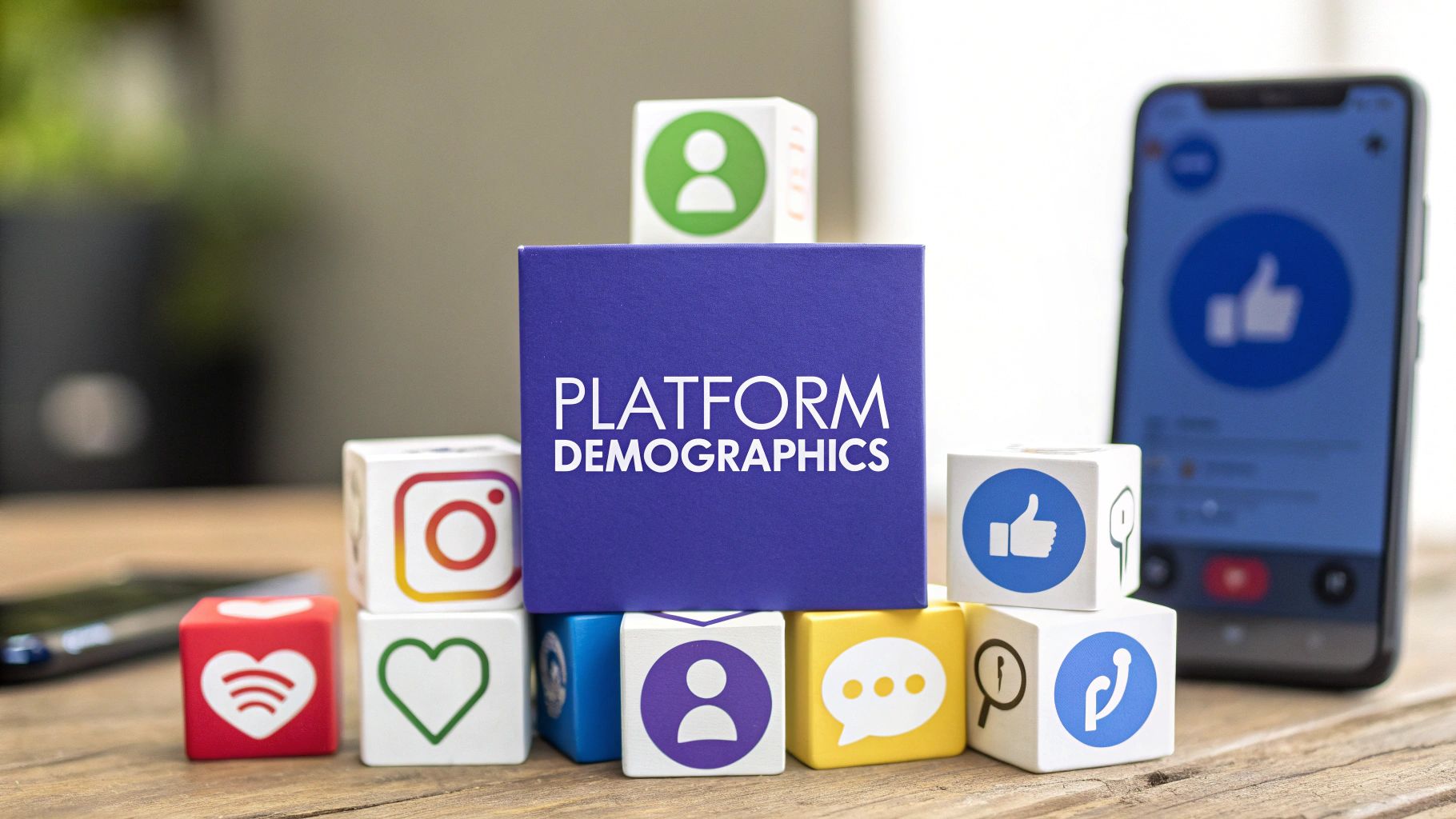If you want to really get a handle on social media automation, you need a plan that goes way beyond just randomly firing off posts. It’s a mix of smart scheduling, finding great content to share, and actually looking at what works. Tools like PostSyncer are perfect for this, letting you keep a consistent brand presence and talk to your audience without being chained to your desk.
This frees you up to focus on the bigger picture—growing your business.
Why Smart Social Media Automation Matters Now

Let’s be honest, the social media world moves at a dizzying speed. Just keeping up feels like a full-time job. The real power of automation isn’t just about clawing back a few hours; it's a genuine strategic advantage. It ensures your brand stays visible and active, even when you’re deep in other mission-critical work.
Think about a solo entrepreneur trying to go toe-to-toe with a big company that has a whole marketing team. With smart automation, that entrepreneur can map out and schedule a month's worth of killer content in a single afternoon. Suddenly, they're maintaining a professional, consistent presence across all their channels, leveling the playing field in a huge way.
Gaining a Competitive Edge
It’s the same story for a marketing agency juggling dozens of clients. Automation lets them manage every account without sacrificing quality or burning out their team. Instead of getting bogged down in the tedious mechanics of posting, they can pour their energy into what really moves the needle: strategy, creativity, and building client relationships. This isn't about cutting corners; it's about building a scalable social media engine that actually fuels business growth.
The numbers don't lie. As we head into 2025, there are roughly 5.45 billion people on social media worldwide. With the average person spending 2 hours and 24 minutes scrolling every day, and 25.9% of them actively looking for products to buy, you simply can't afford to be invisible.
Key Takeaway: Effective automation isn't about being less human; it's about being more strategic. It frees up your most valuable resource—time—to focus on genuine engagement and big-picture planning.
Let's look at the concrete benefits automation brings to the table.
The Strategic Impact of Social Media Automation
This table breaks down the core benefits your business gains by automating social media tasks effectively.
| Benefit | Impact on Your Business | Real-World Example |
|---|---|---|
| Time Savings | Frees up hours each week for high-value tasks like strategy, customer interaction, and product development. | A small e-commerce brand schedules a month of product posts, freeing up the owner to focus on sourcing new inventory. |
| Consistency | Maintains a constant brand presence, keeping you top-of-mind with your audience and satisfying platform algorithms. | A B2B consultant schedules daily industry tips on LinkedIn, establishing themselves as a thought leader without daily effort. |
| Data-Driven Decisions | Provides clear analytics on what content resonates, allowing you to double down on what works and ditch what doesn't. | A restaurant analyzes post-performance and discovers that behind-the-scenes kitchen videos get 3x more engagement than food photos. |
| Scalability | Allows you to manage multiple social profiles and campaigns simultaneously without needing to hire more staff. | A marketing agency onboards five new clients and seamlessly integrates their social media schedules into their existing workflow. |
By systemizing your social media, you’re not just saving time—you’re creating a more resilient and effective marketing operation.
Beyond Simple Scheduling
Thinking about how to automate social media marketing has to go deeper than just scheduling. A truly solid system includes:
- Content Curation: Automatically finding and sharing relevant industry news and articles to keep your feed fresh and valuable.
- Performance Analysis: Using built-in analytics to spot your winning posts and understand why they worked so you can replicate that success.
- Audience Engagement: Setting up alerts for brand mentions or keywords so you can jump into conversations the moment they happen.
When you weave all these elements together, you create a system that’s working for you around the clock. To get started on the right foot, it’s essential to build on a foundation of proven social media marketing strategies that tie back to your core business goals. That’s how you ensure every automated action is purposeful and delivers real results.
Building Your Social Media Automation Plan
Jumping straight into automation without a clear strategy is like setting sail without a map. Before you even think about scheduling your first post, you need a solid game plan. A well-thought-out strategy makes sure every automated action you take is purposeful and inches you closer to your actual business goals.
First things first: what does success even look like for you? Are you trying to drive more traffic to your website? Generate qualified leads for your sales team? Or is your main focus on building brand awareness and community engagement? Your goals will completely shape the type of content you create and automate.
Defining Your Core Content Pillars
Once you know where you're going, you can map out your core content pillars. Think of these as the main themes or topics your brand will consistently talk about. For a fitness brand, pillars might include workout tips, healthy recipes, and motivational stories. For a SaaS company, they could be industry news, product tutorials, and customer success stories.
These pillars are the foundation of your content library. I like to think of this library as an arsenal of pre-approved posts, ready to be deployed at a moment's notice. A strong library needs a healthy mix of content to keep your audience from getting bored.
- Evergreen Content: These are your timeless posts—think how-to guides or foundational industry tips that stay relevant for months, or even years. They're perfect for filling gaps in your schedule and can be republished down the road.
- Promotional Posts: This is everything from new product announcements to special offers. Automating these ensures you’re always promoting without having to do it manually every single time.
- User-Generated Content (UGC) & Testimonials: Sharing customer photos or glowing reviews is incredibly powerful social proof. Schedule these to build trust and credibility over time.
- Industry News & Curated Content: Sharing relevant articles from other sources positions you as a valuable resource, not just a brand trying to sell something.
Building a diverse content library is the secret sauce. It ensures your automated feed feels fresh and valuable, not repetitive. It’s the difference between a thoughtful, automated strategy and a robotic one.
Structuring Your Editorial Calendar
With your pillars and content library taking shape, it's time to build an editorial calendar. This isn't just a schedule; it's a strategic blueprint for your entire social media presence. It lets you visualize your content flow, plan campaigns in advance, and make sure you have a balanced mix of posts from all your different pillars.
Having a structured calendar is absolutely critical when you automate social media marketing because it provides the framework for everything else. For a detailed guide and a ready-to-use framework, check out this helpful social media marketing plan template to get started. This strategic approach ensures your automated efforts aren’t just consistent, but also highly effective and perfectly aligned with your bigger marketing goals.
Choosing the Right Automation Tools for Your Needs
Let's be honest: the number of social media automation tools out there can be paralyzing. They all promise to save you a mountain of time and skyrocket your results, but here’s the secret: the best platform is the one that actually fits your workflow, not one that forces you to change how you work.
The right choice really boils down to three things: your budget, your team's size, and which social media platforms matter most to your brand. A solo creator, for instance, just needs a simple, reliable scheduler that doesn't break the bank. But a marketing agency juggling a dozen clients? They need the heavy-duty stuff—collaboration features, client approval workflows, and deep analytics for reporting. That's where a platform like PostSyncer really starts to flex its muscles.
There's a reason the marketing automation market is exploding. Projections show it will swell to $14.55 billion by 2031. It’s not just hype; a recent report found that 49% of marketing leaders are already automating their social media. The trend is clear: efficiency is the name of the game.
Evaluating Core Features
When you're comparing tools, it's easy to get distracted by flashy features. My advice? Zero in on the things that will actually make your day-to-day life easier. A clean, intuitive interface and rock-solid reliability are absolutely non-negotiable.
To give you an idea of what's out there, here's a look at how different dashboards are laid out.

As you can see, the best platforms pull everything—scheduling, analytics, and content management—into one clean view. This isn't just a nice-to-have; it's essential for a smooth workflow.
Before you commit, make sure any tool you're considering has these must-haves:
- Platform Support: Does it connect to all the social networks where your audience actually hangs out? Don't pay for a bunch of integrations you'll never use.
- Content Scheduling: A visual, drag-and-drop calendar is a must. And trust me, features like bulk scheduling and evergreen content queues are massive time-savers.
- Analytics and Reporting: The tool has to give you clear, actionable data. If you can't easily track engagement, reach, and click-through rates, how will you ever prove your ROI?
- Collaboration Tools: If you work with a team, things like draft approvals, different user roles, and shared content libraries are critical for keeping your brand voice consistent.
When you're weighing your options, checking out guides on the top social media automation tools can give you a great starting point and help you compare features side-by-side.
A great tool doesn't just automate tasks; it provides the insights you need to make smarter marketing decisions. If the analytics are confusing or shallow, you’re flying blind.
When you're vetting potential tools, having a clear checklist of what matters most for your specific workflow is key. This table breaks down the essentials.
Comparing Social Media Automation Tool Features
| Feature | What to Look For | Why It Matters for Your Workflow |
|---|---|---|
| Scheduling & Posting | Visual calendar, bulk upload, recurring post queues, best-time-to-post suggestions. | This is the core function. A good scheduler saves hours and ensures a consistent presence without manual effort. |
| Platform Integration | Support for all your key networks (e.g., Instagram, TikTok, LinkedIn, Facebook). | Avoids the need for multiple tools and centralizes your entire social media operation in one place. |
| Analytics & Reporting | Customizable dashboards, post-performance metrics, audience growth tracking. | Without solid data, you're just guessing. Good analytics show you what's working so you can double down on it. |
| Team Collaboration | User roles, approval workflows, shared content libraries, internal comments. | Essential for agencies and teams to maintain brand consistency and prevent rogue posts from going live. |
| Inbox Management | Unified inbox to manage comments and DMs from all platforms in one stream. | Dramatically speeds up community management and ensures no customer interaction gets missed. |
Ultimately, the goal is to find a platform that feels like an extension of your team, not another complicated piece of software you have to fight with.
Beyond Scheduling: Other Tool Categories
A truly comprehensive social media strategy often relies on more than just a scheduler. While an all-in-one platform like PostSyncer covers most of your bases, it’s smart to know what other types of tools are out there. Our guide on the best social media automation tools takes a much deeper look into these different categories.
You might also want to look into platforms for:
- Content Curation: These tools are great for finding and sharing high-quality content from other sources in your industry, keeping your feed fresh.
- Social Listening: Think of these as your brand's ears on the internet. They monitor mentions and keywords, letting you jump into relevant conversations in real-time.
- Contest & Giveaway Management: If you run a lot of interactive campaigns, specialized tools can handle the logistics and help you boost engagement without the manual headache.
The idea is to build a tech stack that supports your strategy without making it overly complicated. My advice? Start with a powerful, central hub for scheduling and analytics, and only add specialized tools as your needs grow.
Your First Automated Workflow in PostSyncer
Bringing your plan to life means actually hitting the publish button—automatically. This is the point where all the strategy work starts saving you hours each week. We’ll start simple with a workflow you can expand as you go.
Connecting Your Social Accounts Securely
The first order of business is granting PostSyncer the right access. You’ll sign in to each platform through PostSyncer’s secure OAuth flow. It takes a minute per network.
Don’t stop at just one or two channels. For a fully integrated presence, link every profile you actively manage. That way, you avoid surprises when it’s time to post.
Building Your First Content Schedule
Now that connections are live, let’s turn your editorial calendar into action. PostSyncer’s drag-and-drop calendar lets you see exactly when each post will go out. No guesswork, just a clear timeline.
Think back to your audience research. A quick reference:
| Audience Type | Best Days | Ideal Times |
|---|---|---|
| B2B (LinkedIn) | Tuesday–Thursday | 9 AM–12 PM |
| Lifestyle (Insta) | Weekends | Evenings |
Use real data before committing. Pull your platform analytics or let PostSyncer’s AI-powered scheduling suggest the sweet spot based on past engagement.
Here are a few content patterns you can automate right away:
- Recurring Themed Posts: A “Behind the Scenes Friday” update every Friday afternoon builds familiarity.
- Evergreen Content Slots: Schedule your best how-to guides or top tips on Tuesday and Thursday mornings.
- Campaign-Specific Content: When rolling out a case study, automate a weeklong sequence across all channels. Tweak each post for the network, like a concise summary on LinkedIn and a question prompt on Facebook.
Tailoring Your Message for Each Platform
Straight-up copy-and-paste never feels right. Your followers know when something reads like a bot. A few minutes of customization makes a world of difference.
Bullet out the details:
- Craft unique captions: Keep Instagram captions punchy and visual, LinkedIn notes professional, and Facebook more conversational.
- Pick the right hashtags: Use broad, trending tags on Instagram, and niche, industry-specific ones on LinkedIn.
- Match your media: Vertical videos thrive in Reels or Shorts, while landscape images shine on Facebook and X (formerly Twitter).
By sprinkling in that extra personalization, your automation feels more like genuine conversation. You’re simply delivering the right story, to the right audience, at the right time—minus the manual grind.
Advanced Automation Strategies for Greater Impact

By now, your scheduler is humming along with the basics. But there’s a difference between simply posting content and running an always-on marketing engine. It’s about swapping one-off uploads for workflows that think on your behalf—spotting opportunities, reacting to real-time events, and keeping your channels active without you staring at a dashboard.
With smarter automation, your channels stop feeling like bulletin boards and start behaving like a live, engaging network—drawing in new eyes and amplifying engagement with minimal effort.
Implement Evergreen Content Queues
One of my go-to tactics is building an evergreen queue in PostSyncer. Picture your top-performing blog posts, how-to guides, or share-worthy tips rotating back into the feed exactly when interest dips. You’re not reposting for the sake of it—you’re strategically resurfacing content that’s proven its worth.
Key benefits include:
• Maximizes Value from your best content over and over.
• Fills Calendar Gaps during hectic weeks when new writing falls by the wayside.
• Reaches Fresh Audiences who weren’t there the first time around.
Evergreen posts are like a trusty workhorse. Automate their comeback tour, and you’ll keep traffic and engagement rolling in—no extra hands required.
Create Smart Triggers And Rules
Moving past static schedules, you can inject real-world signals into your workflow. Think “if this happens, then do that” logic—so your channels fire off posts the moment it matters.
Here’s a scenario I set up recently:
• An RSS feed from our blog spots new articles as they publish.
• PostSyncer springs into action, drafts a social post, and adds it to the front of the queue.
• Within minutes, LinkedIn, Twitter, and Facebook see the fresh link—and engagement starts ticking up organically.
Beyond that, explore more sophisticated tactics and strategies for automating content creation to push boundaries even further.
Why This Matters
Automation isn’t just a time-saver—it reshapes your entire approach. Consider these eye-opening stats:
• 47% of marketers have automated social media management, making it the second most automated marketing channel.
• Small teams can recoup roughly 6 hours per person each week, totaling 300+ hours a year.
For a deeper dive into how brands are capitalizing on these tactics, check out how businesses are adopting automation on inbeat.agency. When you swap manual posting for intelligent workflows, you’re not just saving time—you’re unlocking growth potential you didn’t know you had.
Answering the Tough Questions on Social Media Automation
Let's be honest: the idea of automating your social media can bring up some serious doubts. The last thing you want is for your carefully curated channels to turn into a robotic feed that screams "nobody's home."
I hear this all the time from marketing teams. They worry they'll lose that human touch and the genuine conversations that build a real community.
So, let's tackle those big questions head-on with some practical, real-world advice.
Will Automation Make My Social Media Feel Robotic?
This is the number one concern, and it's a valid one. But here’s the secret: automation should never replace your voice; it should just amplify it. Think of it as a tool to handle the repetitive, behind-the-scenes work, freeing you up to focus on what really matters—authentic interaction.
Schedule your evergreen content, your weekly tips, and your promotional posts in advance. But reserve your live moments for jumping into the comments, replying to DMs, and engaging with real-time trends.
Automate the events, not the empathy. Let the tool handle the posting, but you show up for the conversation.
I worked with a boutique agency that mapped out their entire month's content calendar in PostSyncer. But they still made it a non-negotiable rule to reply to every single message personally. The result? Their followers see consistent, timely posts and get real human responses. It's the best of both worlds.
What Is The Biggest Mistake With Social Media Automation?
Without a doubt, the most common blunder is the "set it and forget it" mindset. You can't just load up a queue and walk away for three months. If you ignore the data, you'll end up pushing stale content that completely misses the mark with your audience.
The other major misstep? Blasting the exact same post across every single platform. What works on a visual-first platform like Instagram is going to flop hard on a professional network like LinkedIn.
Your goal is to be efficient, not lazy. Tailor your content for each network, but schedule it smartly:
- Craft unique captions that match the tone of each platform.
- Use platform-specific hashtags and formats (like threads on X or carousels on LinkedIn).
- Adjust your media to what works best, whether it's a Reel, a Story, or a simple text post.
This approach lets you automate the process without sacrificing the quality and authenticity that actually drives engagement.
How Do I Measure Automation Success?
Your metrics need to be tied directly back to your business goals. It's time to move beyond vanity numbers like follower counts and focus on what's actually making an impact.
Here are the big three to watch:
- Engagement Rate: This is your bread and butter—tracking the likes, comments, and shares on each post.
- Click-Through Rate (CTR): Are people actually clicking the links you share? This tells you if your call to action is working.
- Conversion Rate: This is the ultimate goal. How many of those clicks are turning into leads, sign-ups, or sales?
Most automation tools, including PostSyncer, have built-in dashboards to track this stuff. The key is to set a regular cadence—I recommend monthly—to review the data, spot trends, and adjust your scheduled workflow. This isn’t a one-time setup; it’s a continuous loop of refining your plan based on real-world performance.
I know a local retailer who saw a 45% jump in their CTR just by tweaking their posting times. They found that insight by reviewing their analytics weekly and making small adjustments to their queue. That's the power of data-driven automation.
Best Practices To Avoid The Pitfalls
Great automation is a partnership between technology and human oversight. You still need to be in the driver's seat. Plan for consistency, but stay agile enough to adapt when needed.
Here are a few practices to keep you on the right track:
- Rotate your evergreen content. Use performance data to see what’s resonating and keep your most popular posts fresh.
- Get a second pair of eyes. For big campaigns or launches, tag a team member to review scheduled posts before they go live.
- Have a "pause" button. When major global events or urgent news breaks, have a protocol to immediately halt your scheduled content.
- Review your analytics regularly. Before you spend time adding new content to the queue, take a quick look at what’s working and what’s not.
Adopting these habits from the start will help you automate your social media marketing without ever losing that crucial, authentic touch.
Ready to level up your automation strategy? Start your free trial with PostSyncer















